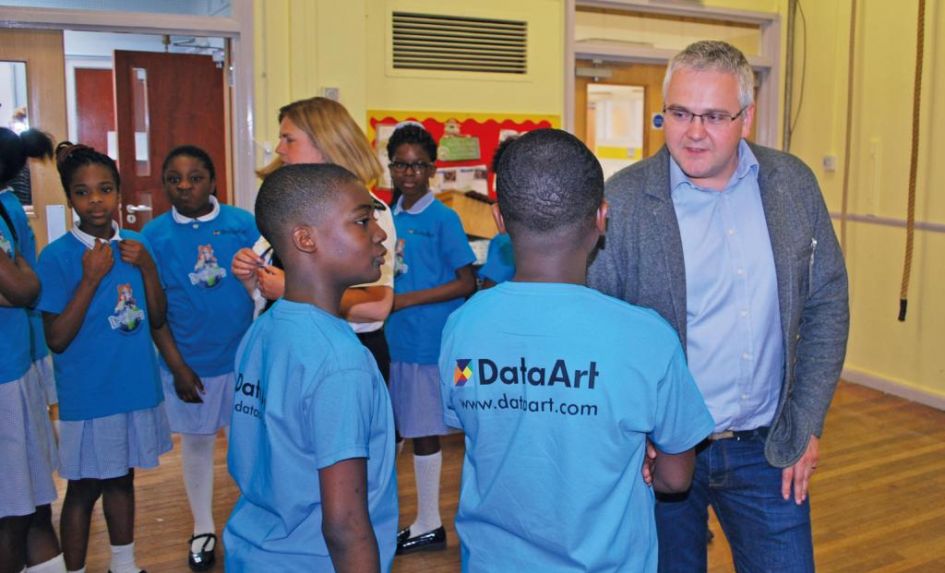Dot Com Digital is an online safeguarding programme – one which has grown and evolved over time with input from children and teachers since its original launch 15 years ago.
The programme has hitherto been delivered using paperbased journals, and is based around the cartoon character of ‘Dot Com’ – a friend to the pupils, a child learning just like they are, and someone therefore speaking to them in their own language.
What the programme has ultimately aimed to do is help deliver messages that the police would like communicated to children via their teachers.
We’ve now taken the step of creating a new online version of the programme called Dot Com Digital. The ideas that went into its development were first discussed at a workshop attended by the chief of Essex Police, companies including DataArt and Microsoft, and Y6 representatives of Holy Cross School in South Ockenden, Essex.
What emerged was the perceived need for a new resource that could be made available to schools for free with the aid of corporate funding, and which could reflect the current level of digital threat.
Growing issues
We’ve seen over the years that the methodology of Dot Com has proven effective. We’ve even seen cases go to court where details of incidents have been disclosed via Dot Com paper journals submitted as evidence. As such, we’ve enjoyed a long partnership with the police.
Ahead of the workshops we organised for Dot Com Digital, I’d previously considered myself quite well informed about the harms children face online.
We frequently receive feedback from schools that use the resource about the different types of disclosures and issues they’re dealing with, but working alongside frontline officers who regularly come into contact with at risk children, I was shocked at the rise of County Lines issue.
This is the practice whereby drug dealers travel around different parts of the country, looking out for vulnerable children who they can potentially groom into committing future crimes. Up to now, it’s a form of criminal activity that’s tended to be fought on on area by area basis, but the threat is now increasingly mobile.
I’ve since sat in Home Office meetings concerning the issue, listening to discussions of how criminals are offering children ‘buy one, get one free’ offers for drugs via a terrible, yet extraordinary use of social media.
It’s also long been the case that bullying doesn’t end at the school gates any more. Incidents involving the use of WhatsApp and other services are on the rise, including cases where as many as two to three thousand malicious messages have been sent to children’s phones overnight.
Consistent patterns
The new Dot Com Digital programme provides children with an online journal they can access via an individual login. They will then work through the journal, answering questions and responding to discussion prompts on a range of different issues, including how to manage and talk about their feelings, how to respond to bullying, and now in the digital version, how to identify and report negative social media use, harmful online material and signs of grooming.
What’s notable about the process is that potential risks can be detected in the children’s responses and automatically brought to their teacher’s attention. Up to now, we’ve been reliant on teachers reading through children’s paper-based journals and identifying any possible issues. When using the online digital journals, teachers can receive risk notifications based on keyword recognition via their own login screen, and can then proceed to engage in conversation with the child.
During my discussions with the police, they outlined to me how the gang- and sex-related grooming of children tends to follow a consistent pattern. Children can therefore be helped to understand how certain things people might want you to do online can have negative outcomes, and be given the skills to identify a safety network of people they can turn to if they’re worried or frightened.
One of the Dot Com lessons in the digital journal is a short video of the Dot character learning those signs herself – ‘if Dot’s knees are wobbly like a jelly, she doesn’t feel safe.’ It’s important that we teach children how to recognise their own ‘flight cycle’ at signs of danger, since this is what they’ll experience when something happens online that makes them feel unsafe, just as they would in the real world.
Future plans
We’re currently in the process of ensuring that the technology works and that teachers are happy with how it’s implemented. When the programme is launched nationally, instructional video resources will be available for teachers to watch, so that they know how to use the resource.
Going forward, the Holy Cross School children we heard from spoke of wanting to see an app version that they and their parents could access at home. In particular they wanted an app that would include an avatar or chatbot similar to the Dot Com character that they could seek help from, which is certainly something I’d like to see in future.
From September 2020, it will be a statutory requirement for primary schools to teach their pupils relationships education and lessons in staying safe online. Our plan is to launch Dot Com Digital in October this year, making it a resource that could potentially help schools to fulfil those new PSHE curriculum requirements. We’ve secured funding for Dot Com Digital up until the end of 2020 – our hope is that we’ll be able to continue offering it to schools as the momentum behind it grows.
Pattern recognition
Anton Bagrov, senior account executive at project partner DataArt, tells us more about Dot Com Digital’s automatic alerts function
The Dot Com Digital system can be made to monitor the content of children’s digital journals and automatically deliver alerts to teachers and designated safeguarding leads. To do so, it will look for certain words – by way of a simple example, if a child answers the question ‘Do you feel safe at home?’ and their response is ‘no’ or ‘never’, that would raise an alert.
Children are also able to insert drawings in their journals, which can be similarly analysed. When a child experiences stress, they will be more likely to share information visually than in writing. Any drawings that might raise an alarm – say, the outline of a knife – can be made to trigger an alert.
The software can further store the history of children’s journal entries and flag any unusual changes or differences. The software lets staff apply as many filters, patterns and level of analysis as they wish, and share comments with teaching colleagues and DSLs. There’s also the ability to share clips from journals directly with parents online via one-time login sessions.
Sharon Doughty is founder of the Dot Com Children’s Foundation.










